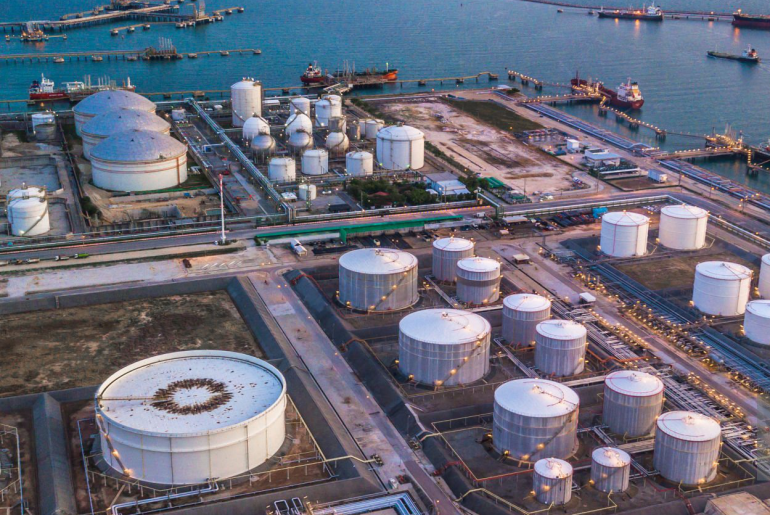Embarking on a journey into the petroleum field demands a strong understanding of Aboveground Storage. This guide will delve into the crucial skills necessary to navigate the intricacies of the storage tank and other fundamental knowledge. From safety procedures to operational know-how, this article acts as your guide in the captivating realm of petroleum skills.
What Is Aboveground Storage Tank?
An Aboveground Storage Tank, often abbreviated as AST, is a large container designed to store liquids above the ground surface. These tanks are large containers that rest on the ground’s surface, commonly used for substances like oil, chemicals, or water.
Unlike underground tanks, ASTs are visible and easily accessible, making them suitable for various industries. Further, aboveground storage tanks are created to store large amounts of liquids or gases, including water, petroleum, gasoline, chemicals, and hazardous waste materials. Their design ensures that the stored liquids are securely contained, and they play a crucial role in providing convenient and safe storage solutions for different materials.
What Is The Difference Between UST and AST?
The difference between UST (Underground Storage Tank) and AST (Aboveground Storage Tank) lies in their placement. USTs are buried beneath the ground, while ASTs, as the name suggests, are located completely above the ground surface.
Both UST and AST serve as containers for storing liquids like water, petroleum, chemicals, or hazardous materials, but their location—whether underground or aboveground—determines their classification. Each type has specific applications and considerations, with USTs often used when space is limited, and ASTs offering visibility and accessibility advantages.
| Aspect | Aboveground Storage Tanks (AST) | Underground Storage Tanks (UST) |
| Use | – Visible and accessible above the ground | – Buried beneath the ground, not visible |
| – Suitable for various industries | – Commonly used when space is limited | |
| – Ideal for storing liquids like oil, chemicals | – Often used for fuel storage in gas stations | |
| Advantages | – Easy to inspect and maintain | – Space-efficient, suitable for limited areas |
| – Reduced risk of groundwater contamination | – Aesthetically less intrusive | |
| – Compliance with regulations is often simpler | – Protection from weather conditions | |
| Disadvantages | – Visible, may impact aesthetics | – Inspection and maintenance challenges |
| – Vulnerable to external elements | – Risk of leaks leading to soil and water pollution | |
| – Limited storage capacity compared to USTs | – Compliance may involve more complex regulations |
What Are The Three Types of Storage Tanks?
There are three most common types of storage tanks:
1. Fixed Roof Tanks
Fixed Roof Tanks are designed with cone- or dome-shaped roofs permanently attached to their shells. There are different types within this category, including supported cone structures, self-supporting tanks without internal structures, and geodesic domes made of aluminum. These tanks provide a stable and secure storage solution, and the various designs cater to different structural requirements.
2. Internal Floating Roof Tanks
Internal Floating Roof Tanks are designed to float on top of the stored product while being covered with fixed roofs. They come in different types, such as steel pan tanks (which require a fixed roof), steel pontoon tanks, and aluminum floating roofs available in full-contact or pontoon-style designs. These tanks are versatile and help minimize product evaporation by reducing the exposed surface area.
3. External Floating Roof Tanks
External Floating Roof Tanks are designed to float on top of the stored product. They include types like steel pontoon tanks and those equipped with aluminum floating roofs. These tanks offer advantages in preventing vapor loss and are particularly suitable for products sensitive to evaporation. The choice between internal and external floating roofs often depends on the specific characteristics of the stored material.
4. Horizontal Tanks
Horizontal Tanks are generally smaller in size, making them easier to move, and are typically shop-fabricated. These tanks offer a more space-efficient storage solution and are often used when space constraints are a consideration. Their horizontal orientation makes them suitable for various applications, providing flexibility in storage options and facilitating easy transportation.
What International Standards Regulate The Aboveground Storage Tanks?
Several international standards govern Aboveground Storage Tanks (ASTs), ensuring their design, construction, and maintenance meet industry and safety requirements. One of the major standards is the API 653 standard.
API 653 (American Petroleum Institute 653) standard specifically addresses the reconstruction, repair, alteration, and inspection of aboveground storage tanks that have been in service. It provides guidelines for maintaining the integrity of these tanks, ensuring they meet safety and environmental standards.
In addition to API 653, other key international standards for ASTs include:
API 650 (American Petroleum Institute 650)
API 650 standard covers the design and construction of large, welded, low-pressure storage tanks. It sets guidelines for the materials, design, fabrication, erection, and testing of these tanks.
BS EN 14015 (British Standards European Norm 14015)
This European standard provides requirements for the design and construction of flat-bottomed, vertical, cylindrical storage tanks with a shell height that exceeds 1.5 meters.
ASTM E2256 (American Society for Testing and Materials E2256)
This standard outlines guidelines for inspecting and evaluating the environmental and atmospheric effects on aboveground, vertical, cylindrical, closed, and open-top steel tanks.
These standards ensure that ASTs are built and maintained to high-quality and safety standards, promoting environmental protection and the longevity of storage tank infrastructure.
In summary, mastering the complexity of Aboveground Storage Tanks (ASTs) is beneficial for professionals in the petroleum industry. These visible and accessible tanks play a crucial role in securely storing diverse liquids and gases. Understanding the differences between USTs and ASTs, exploring various tank types, and adhering to international standards, notably API 653, ensures safety, environmental protection, and the longevity of storage tank infrastructure.
For professionals seeking practical expertise in AST management, PetroSync offers specialized API 653 training. This program goes beyond theoretical knowledge, focusing on a practical approach with real case studies. You can gain valuable insights and skills, equipping you to navigate the complexities of maintaining and inspecting ASTs effectively. Mastering API 653 through PetroSync ensures a comprehensive understanding of the industry’s best practices and real-world applications.
Credit header image: iStock

SEO specialist by day, fact-checker by night. An avid reader and content writer dedicated to delivering accurate and engaging articles through research and credible sources.







